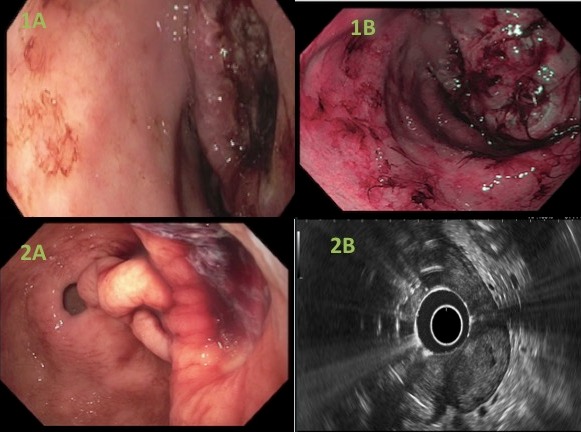Back


Poster Session A - Sunday Afternoon
Category: Stomach
A0700 - Gastric Glomus Tumors: Silent Until Ulcerated
Sunday, October 23, 2022
5:00 PM – 7:00 PM ET
Location: Crown Ballroom

Has Audio
.jpg)
Lily Kuo, MD
University of Texas Health San Antonio
San Antonio, TX
Presenting Author(s)
Lily Kuo, MD, Muhammad Haris, MD, Juan Echavarria, MS, MD, Chandraprakash Umapathy, MD
University of Texas Health San Antonio, San Antonio, TX
Introduction: Glomus tumors are rare and mostly benign mesenchymal neoplasms comprising fewer than 2% of all soft tissue tumors. They arise from the modified smooth muscle cells (glomus cells) of the glomus body, an arteriovenous shunt typically found in peripheral soft tissue of the extremities. Rarely, glomus tumors can occur in the gastrointestinal (GI) tract, where they arise from the submucosa or muscularis propria. We present two interesting cases of gastric glomus tumor (GGT) with different clinical outcomes.
Case Description/Methods: A 46-year-old female presented with shortness of breath and fatigue for 3 months. Labs showed iron deficiency anemia with a hemoglobin of 4.4 gm/dl. Esophagogastroduodenoscopy (EGD) revealed a large, ulcerated, partially circumferential mass in the gastric antrum (Fig 1A, 1B). Imaging showed a solid 7.8 cm mass in the gastric antrum with multiple hepatic metastases. Gastric biopsy showed glomus tumor, with a positive smooth muscle actin (SMA) stain and abundant background necrosis. Liver biopsy also confirmed metastasis of the glomus tumor. Patient is currently undergoing chemotherapy to downsize the primary tumor before surgical intervention.
A 72-year-old female with a history of breast cancer was admitted with hematemesis and melena. EGD revealed a large submucosal ulcerated gastric mass with signs of bleeding. Endoscopic ultrasound (EUS) showed the mass was arising from the muscularis propria, in the antrum of the stomach (Fig 2A, 2B). Fine needle aspiration was performed which expressed only synaptophysin (Syn), suggestive of gastric neuroendocrine tumor. Patient underwent an exploratory laparotomy and distal gastrectomy for continued GI bleeding. The tumor was sent for surgical pathology, which expressed both smooth muscle actin and Syn, confirming glomus tumor. The patient was stable following gastrectomy.
Discussion: GGTs account for approximately 1% of all GI mesenchymal tumors and are difficult to differentiate from other richly vascularized tumors, such as gastrointestinal stromal tumor (GIST). The definitive diagnosis relies on EGD, histopathologic examination with immunohistochemical staining and EUS-guided fine-needle aspiration. Glomus tumor cells stain positive for SMA and vimentin, while Syn and CD34 can be positive in some cases. Surgical resection is the treatment of choice and offers a favourable prognosis. Metastatic spread as seen in one of our cases is extremely rare. There are no standard of care chemotherapeutic regimens for treatment of GGTs.

Disclosures:
Lily Kuo, MD, Muhammad Haris, MD, Juan Echavarria, MS, MD, Chandraprakash Umapathy, MD. A0700 - Gastric Glomus Tumors: Silent Until Ulcerated, ACG 2022 Annual Scientific Meeting Abstracts. Charlotte, NC: American College of Gastroenterology.
University of Texas Health San Antonio, San Antonio, TX
Introduction: Glomus tumors are rare and mostly benign mesenchymal neoplasms comprising fewer than 2% of all soft tissue tumors. They arise from the modified smooth muscle cells (glomus cells) of the glomus body, an arteriovenous shunt typically found in peripheral soft tissue of the extremities. Rarely, glomus tumors can occur in the gastrointestinal (GI) tract, where they arise from the submucosa or muscularis propria. We present two interesting cases of gastric glomus tumor (GGT) with different clinical outcomes.
Case Description/Methods: A 46-year-old female presented with shortness of breath and fatigue for 3 months. Labs showed iron deficiency anemia with a hemoglobin of 4.4 gm/dl. Esophagogastroduodenoscopy (EGD) revealed a large, ulcerated, partially circumferential mass in the gastric antrum (Fig 1A, 1B). Imaging showed a solid 7.8 cm mass in the gastric antrum with multiple hepatic metastases. Gastric biopsy showed glomus tumor, with a positive smooth muscle actin (SMA) stain and abundant background necrosis. Liver biopsy also confirmed metastasis of the glomus tumor. Patient is currently undergoing chemotherapy to downsize the primary tumor before surgical intervention.
A 72-year-old female with a history of breast cancer was admitted with hematemesis and melena. EGD revealed a large submucosal ulcerated gastric mass with signs of bleeding. Endoscopic ultrasound (EUS) showed the mass was arising from the muscularis propria, in the antrum of the stomach (Fig 2A, 2B). Fine needle aspiration was performed which expressed only synaptophysin (Syn), suggestive of gastric neuroendocrine tumor. Patient underwent an exploratory laparotomy and distal gastrectomy for continued GI bleeding. The tumor was sent for surgical pathology, which expressed both smooth muscle actin and Syn, confirming glomus tumor. The patient was stable following gastrectomy.
Discussion: GGTs account for approximately 1% of all GI mesenchymal tumors and are difficult to differentiate from other richly vascularized tumors, such as gastrointestinal stromal tumor (GIST). The definitive diagnosis relies on EGD, histopathologic examination with immunohistochemical staining and EUS-guided fine-needle aspiration. Glomus tumor cells stain positive for SMA and vimentin, while Syn and CD34 can be positive in some cases. Surgical resection is the treatment of choice and offers a favourable prognosis. Metastatic spread as seen in one of our cases is extremely rare. There are no standard of care chemotherapeutic regimens for treatment of GGTs.

Figure: Two gastric glomus tumors seen on esophagogastroduodenoscopy (EGD) and endoscopic ultrasound (EUS).
Disclosures:
Lily Kuo indicated no relevant financial relationships.
Muhammad Haris indicated no relevant financial relationships.
Juan Echavarria indicated no relevant financial relationships.
Chandraprakash Umapathy indicated no relevant financial relationships.
Lily Kuo, MD, Muhammad Haris, MD, Juan Echavarria, MS, MD, Chandraprakash Umapathy, MD. A0700 - Gastric Glomus Tumors: Silent Until Ulcerated, ACG 2022 Annual Scientific Meeting Abstracts. Charlotte, NC: American College of Gastroenterology.
